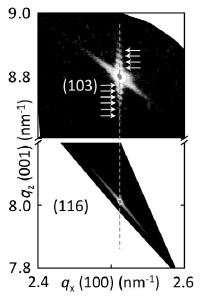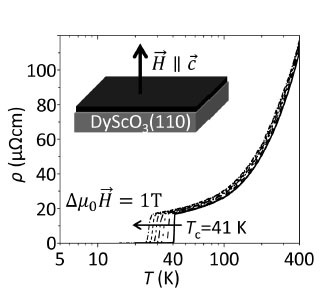Materials Science Laboratory
Infinite layer cuprate superconductors are built up only by CuO2 planes spaced by Sr or La. Consequently, their crystal structure is the
simplest among all of the cuprate superconductors. However, the synthesis
of the infinite layer phase remains arduously as the tetragonal crystal
structure (P4/mmm, S.G. 221) is stabilized only under high pressure synthesis conditions [1]. Nonetheless, early studies have shown that Sr1-xLaxCuO2 thin films can be grown by molecular beam epitaxy (MBE) [2]. In contrast
to bulk samples synthesized under high pressure, single phase thin films
readily allow electronic transport measurements. We have synthesized high
quality infinite layer cuprate superconductors by MBE [3]. Crucial growth
parameters are a stringent stoichiometry control which was done by electron
impact emission spectroscopy. Beside the stoichiometry of the cations,
the oxidizing conditions during the growth play a significant role for
the appearance of superconductivity. Infinite layer cuprate films grown
by MBE have been analyzed by high resolution transmission electron microscopy.
Over large areas (>1000 nm2) crystalline imperfections are not observed, in contrast to films synthesized
by other methods. Those films are grown coherently on DyScO3(110) as shown in Fig. 1. Notably Laue oscillations are also observed the
reciprocal space map (Fig. 1). In Fig. 2, we show the temperature dependence
of the resistivity. Metallic conduction as well as an RRR value of >4
are observed. Also shown in Fig. 2 are the magneto resistivity curves,
where the magnetic field is applied perpendicular to the CuO2 planes. In addition to the resistive transition into the superconducting
phase, we also observed a clear Meissner shielding by a SQUID magnetometer.
The residual resistivity of those films is estimated to be approximately
10 µΩcm, thus small enough for further investigations on the Fermi
surface of infinite layer
cuprate superconductors from Shubnikov - de Haas oscillations.
[1] M. G. Smith et al., Nature 351 (1991) 549.
[2] S. Karimoto et al., Appl. Phys. Lett. 79 (2001) 2767.
[3] Y. Krockenberger et al. Appl. Phys. Exp. 5 (2012) 043101.
 |
 |
|||||
|
|